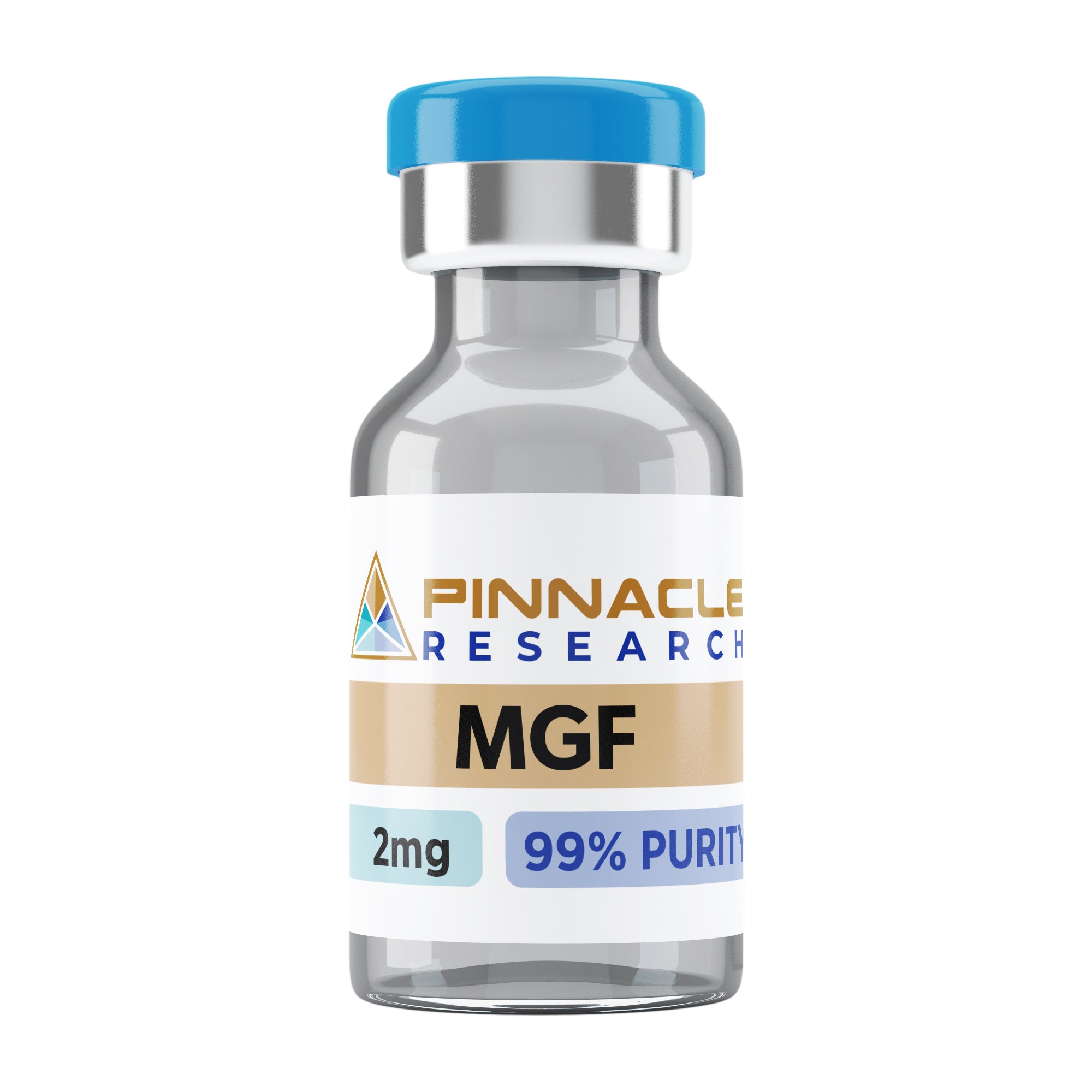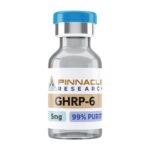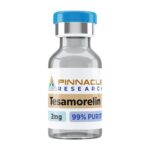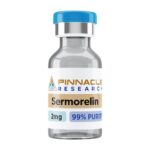About MGF
The MGF (C-terminal) is a splice-genre of IGF-1, an insulin-like growth factor-1. Research shows that MGF positively affects cardiac repair, skeletal muscle repair, tissue growth, and wound healing. Additional scientific evidence indicates that the peptide improves muscle repair after an injury and enhances faster recovery after an exercise or injury. There are speculations that the peptide can protect vulnerable tissues like cartilage against mechanical stresses when one is running, weight training, or engaged in a repetitive motion. Read on to learn more about MGF (C-terminal), its chemical structure and its overall health benefits.
What is MGF (Mechano-Growth Factor)?
MGF (Mechano-Growth Factor) is also C-Terminal and is a synthetic splice version of the insulin-like growth factor-1. Despite occluding naturally in the body, the peptide can be manufactured artificially, and the synthetic version can imitate the effects of the naturally occurring MGF. The peptide plays a vital role in cardiac repair, tissue growth, and wound healing. Its efficiency is predominantly crucial in triggering muscle repairs after the onset of an injury, training or illness.
Scientists have gained immense interest in MGF because it offers protection against mechanical overload, which triggers faster healing in slow-healing body tissues. New research on the peptide reveals that the particular isoform can activate the satellite cells, protect neurons, and counteract muscle-wasting effects caused by aging.
MGF (Mechano-Growth Factor) Chemical Structure
- Sequence: Tyr-Gln-Pro-Pro-Ser-Thr-Asn-Lys-Asn-Thr-Lys-Ser-Gln-Arg-Arg-Lys-Gly-Ser-Thr-Phe-Glu-Glu-Arg-Lys-Cys
- Molecular Formula: C124H204N42O41S1
- Molecular Weight: 2971.99 g/mol
- Synonyms: Mechano-growth factor, IGF-1Eb
Alternative Splicing of IGF-1 Creates MGF
Alternative splicing has become very popular among scientists and researchers. Alternative splicing refers to the ability of a cell to generate mRNA strands differently and produce protein variations from the same DNA sequence. The insulin-like growth factor-1(IGF-1) falls on the end of alternative splicing and has multiple transcription sites and six exons. It can be spliced into two primary classes, each constituting three critical isoforms (IGF-1Ea, IGF-1Eb, IGF-1Ec). Thus creating a minimum of six different proteins, which scientists can further modify to develop more peptides.
MGF Research and Effects
Aging and Levels of MGF
Aging has plenty of side effects on an individual’s overall health. The body experiences slow metabolism and decreased production of crucial hormones. MGF is a specific version of the insulin-like growth factor-1, and its production depends on various factors. Splicing of IGF-1 is affected by age, steroid hormones, development cues in the body, and growth hormones. The factors also affect the peptides produced at the end of IGF-1 alternative splicing.
Age happens to be one of the critical factors which affect the expression of the various IGF-1 isoforms. In a study, researchers observed that younger men preferred class one and class two isoforms. On the other hand, older men showed a psychological and statistical shift to the class 1Ea isoforms. Even though the observations from the study could be more straightforward and more concise regarding how aging affects the IGF-1 and MGF, they offer an experimental starting point for more research. It is suspected that MGF supplementation can reduce muscle-diminishing effects caused by aging.
Inflammation
The particular signaling molecules released by inflammatory cells mediate muscle cell regeneration. Muscle cell regeneration predominantly depends on the macrophages, which are responsible for the production of the MGF peptide during muscle cell inflammation. Studies show that MGF has anti-inflammatory effects and prolongs the lifespan of macrophages. Researchers are yet to elucidate the significance of this effect, but it is suspected that the exogenous MGF administration affects the macrophages, thus boosting the muscle cell healing rates.
Muscle Growth and Optimization of Physical Training
Scientific evidence shows that MGF activates muscle stem cells, triggering hypertrophy and muscle repair. In a research study involving mice, after three weeks of administration of intramuscular MGF injection, the mice experienced a 25% increase in lean muscle mass. Findings from the study suggest that the peptide can prevent the effects of muscle wasting diseases and be used in enhancing workout sessions. Boosting muscle mass aids in fat-burning and weight loss through improved basal metabolism rates. Dealing with obesity and the side effects of overweight complications can be handled by triggering lean body mass gains even with moderate workouts.
Transplanting muscle cell precursors is one treatment therapy used in dealing with muscle-wasting diseases like Duchenne muscular dystrophy (DMD). The treatment has been shown to improve dystrophin expression while offsetting some effects of the illness. Unfortunately, the treatment option has meager survival rates. However, a new research study involving mouse models suggests that MGF can increase the survival rate of the precursors of muscle cells, increasing the success rate of the transplant procedure.
Cartilage Repair
Cartilage damage can happen during an injury, inflammatory disease, accident or overuse of osteoarthritis (joints). Unfortunately, the cartilage healing process tends to be more complicated and takes longer for various reasons. Among the popular reasons for the slow healing of the cartilage include death of stem cells that are needed for regeneration and inadequate blood supply. MGF can help deal with the challenges faced by cartilage repair.
The MGF peptide helps chondrocytes survive when one engages in mechanical stimuli. The chondrocytes are responsible for cartilage regeneration and overall health. When the cartilage experiences mechanical stress, the peptide increases the survival rate of the chondrocytes by protecting them from any stress or injury caused by the movement. These effects were mediated through various pathways, thus promoting chondrocyte migration into cartilage.
Additionally, the peptide has been found to prevent long-term disability and injury to the cartilage. Mechanical overload is one of the leading causes of disc degeneration of the human spine. When the chondrocytes are overloaded, they undergo apoptosis, a programmed cell death. A research study on rodents shows that MGF can prevent apoptosis and disc degeneration. There are ongoing clinical studies on how MGF can be used to reduce spinal degeneration caused by mechanical overload.
Neuron Health and Brain Development
A 2010 research study on mice showed the presence of MGF could enhance the development of the brain by causing neuroprotective effects. Recent studies have shown that the MGF peptide is highly expressed during brain hypoxia and is overexpressed in sections of the brain where neuron regeneration takes place. Speculations about the benefits of MGF to neuron health were confirmed by the mouse model of ALS (Lou Gehrig’s disease) study. When administered, MGF improved the progressive muscle weakness and slowed the loss of motor neurons (the primary cause of (ALS). Findings from the study also revealed that MGF was a more potent treatment option for ALS than the other IGF-1 isoform. Scientists are investigating ways in which MGF can be used to improve muscle function and protect motor neurons from dying.
Protection of Heart Cells
A research study was done on sheep who suffered a heart attack (acute myocardial infarction). Researchers observed that MGF protected the heart muscles from ischemia, and after administration, there was a 35% decrease in cardiomyocyte compromise. There is limited scientific research on how the impact of a heart attack can be reduced when it occurs. Most of the time, patients are administered clot-busting drugs or short of stent placement, but still, in cases of acute heart attack, very little can be done to save the victim. The current treatments focus on protecting the tissues after the heart attack and restoring the heart’s normal functionality. With MGF, scientists have an opportunity to explore alternative treatment options for acute heart attacks when the event is occurring and reduce the damages caused.
MGF is getting more attention from scientists due to its impressive cell regeneration and protection capabilities, which can be instrumental in improving cardiovascular health. Currently, the peptide shows immense potential in protecting various muscle cells in the body. New aspects of the MGF peptide are being uncovered, creating new pathways for pharmaceutical development and breakthrough treatments, especially for terminal illnesses. When used on mice, the peptide showed low oral, excellent subcutaneous bioavailability and minimal side effects. Currently, the peptide is available for research purposes.
MGF is known for boosting cartilage health and protecting neurons. The peptide has a wide area for applications and research to uncover more overall health benefits.




